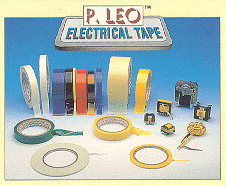

(1) Backing : This part provides insulation and protection of the tape. The backing chosen for a tape should be in accordance with the different functional properties and requirements of the electrical component that the tape will be combined with. There are various types of backings, and details will be discussed in the next section.
(2) Adhesive : Similar to backing, it is also a very important part of an electrical insulating tape. Besides it's adhesive power, it is necessary for the adhesive to be compatible with the commonly used resins, varnishes and solvents. Extensive quality control is needed to avoid diffusion of chemicals such as sulphide and chloride, etc.
(3) Primer coating : Certain electrical insulating tapes need a primer coating to improve the adhesion between the backing and adhesive. The primer coating should have the same electrical grade and solvent resistance as the adhesive.
(4) Release coating : This part is coated on the surface of the tape's backing to allow the tape to be pulled out or rolled back easily. The coating should have good adhesion resistance. It's physical and electrical properties should also be able to meet relevant requirements.
BACKING
 Electrical Insulating Tapes
Electrical Insulating Tapes  UL File No. E126174 are made from a variety of backings to suit the requirements of different applications, including :
UL File No. E126174 are made from a variety of backings to suit the requirements of different applications, including :
(1) Polyester : Thin, durable, and have high dielectric strength. They also exhibit excellent chemical, solvent and moisture resistance. Approved for temperatures up to 130 °C and flame retardancy. Examples are 1P801, 1P802 and 1PFRS.
(2) Glass cloth : Conformable, flexible, and possess excellent absorbent power of resins and varnishes. Glass cloth has very high temperature rating and tensile strength. Approved for temperatures up to 180 °C and flame retardancy. Examples are 1G08S, 1G180 and 1G006.
(3) Filament reinforced : Possess both the high dielectric strength of polyester film and high tensile strength of glass cloth, with lower cost than the glass cloth. Application temperature up to 130 °C. Example is 1PG880.
(4) Polyimide :1K063 Suitable to be used in electrical components that undergo
extreme temperature variations. In this condition, the tape's physical and
electrical properties will remain stable. The backing is Kapton ®
which is a Du Pont product. 1K063 with UL temperature rating at 220°C and flame retardant.
1K063CR is made by
Corona resistance Kapton® CR designed to withstand corona discharge which can cause ionization and eventual breakdown of an insulation meterial when voltage stress
reaches a critrical level. 1K06A polyimide tape with Acrylic Adhesive (rating at 180°C ) and 1K220 polyimide tape with Silicone Adhesive, (rating at 220°C )
(5) Nomex ® Paper : Excellent solvent resistance. The backing is Nomex® which is also a Du Pont product. P.LEO# 1N012, 1N155 with UL temperatures rating at 155 °C and flame retardancy.
(6) Acetate :Possess excellent comformabilty and excellent absorptivity of resins and varnishes. P.LEO# 1A025 UL temperatures rating at 130 °C and flame retardancy.
(7)Metal foil :Use metal foil, including aluminum, copper and tin-plated copper as backing. Their usage are quite different from the general insulating tapes. When used for shielding, they reduce substantially the noise produced by electrical components and therefore minimize the interference. e.g. 1E075, 1E070, 1ECE7, 1AA02, 1AA03
(8) Polyethylene naphthalate (PEN) film 1PEN2, 1PN2R made by Teonex ® Pen Film is DuPont's biaxially oriented polyethylene naphthalate (PEN) film. This new product range has been developed specifically to meet your needs for cost effective films with performance between that of polyethylene terephthalate (PET) and polyamide. Teonex ® Q51 Pen Film and P. Leo Pen Tape can be applied as major insulation in Class F, H and N Electrical Insulation System.
(9) Polyphenylene Sulfide (PPS) TAPE : 1PS25 PPS film with excellent heat resistance and physical strength. It is designed for high temperature application of chop type aluminum foil condenser, insulation of the electrodes of lithium ion secondary battery or high temperature transformers and Inverter transformers for LCD backlighting.
(10) Other : There are other types of backing and materials such as Epoxy, Composite, Teflon cloth, Cotton and Paper, which will not be detailed here.
ADHESIVE
Choosing adhesive is similar to backing. It depends on the applications and temperature rating. There are four main types of adhesives:
(1) Thermosetting rubber : This kind of adhesives has good adhesion power. Under certain temperatures, they react and form three-dimensional molecular structure which have increased strength of adhesion, bonding, and solvent resistance. Usually, this system requires the addition of tackifier. And different types of fillers can be added to meet the specific requirements and properties.
(2) Acrylic : Acrylic adhesives are synthetic polymers, and can be compounded for good resistance to heat, oxidation, solvent and oil.
(3) Thermosetting silicon : These types of adhesives have similar properties of the thermosetting rubbers, but with higher thermosetting temperature up to 260°C. They therefore have excellent heat resistance, and may also be applied at low temperatures. Thermosetting silicon is inorganic polymers, and will leave a nonconductive residue after burned.
(4) Nonthermosetting rubber : These types of adhesives will not advance in cure upon application of heat. Most of the adhesives used in the electrical insulating tapes are chosen to suit the backings in order to meet particular requirements. Except for some special electrical components or manufacturing processes, you may only need to choose a suitable backing for your application.
Guide to Tape Selection
There are eight considerations when selecting the right tape for you :
|
|

|

|
|
 ® is P. Leo & Co., Ltd. trade mark.
® is P. Leo & Co., Ltd. trade mark.
